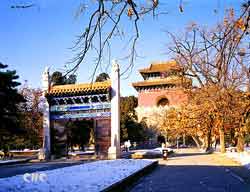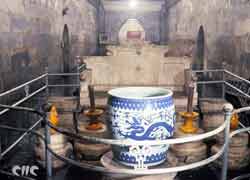|
Although Beijing has been the capital of China for five dynasties, the only imperial mausoleums in the immediate vicinity of the city today are those of the Liao and Qing emperors are in the northeast China and in Hebei Province respectively. The tombs from the Jin Dynasty were destroyed at the end of the Ming Dynasty, and since the Mongol rulers of the Yuan Dynasty had no specific funeral rituals, there are no extant burial sites from this period.
The Ming tombs lie in a broad valley to the south of Tianshou (Longevity of Heaven) Mountain in Changping County, about 50 kilometers northwest of Beijing proper. To the southwest of this valley, a branch of the Yanshan Range suddenly to breaks off and forms a natural gateway to the 40-quare-kilometer basin in which the tombs were built. This gateway is "defended" on each side by the Dragon and Tiger hills, which are said to protect this sacred area from winds carrying evil influences. Thirteen out of the 16 Ming emperors are buried in this peaceful valley.
Visitors first pass by an elegant, five-arched white marble memorial archway. Built in 1540, this 29-meter-wide and 14-meter-high structure, with its delicate bas-relief carvings of lions, dragons and lotuses, is still in near-perfect condition. About one kilometer to the northeast of this archway stands the Great Red Gate (Dahongmen), the outermost gate of the entire mortuary complex.

The Great Red Gate marks the beginning of the 7-kilometer-long Sacred Way (Shendao), which leads to the entrance of the Changling, the tomb of Emperor Yongle (reigned 1403-1424). Continuing on, one comes to a tall square stela pavilion, with four tall white stone ornamental columns (huabiao) set at each of its four corners, standing boldly in the center of the Sacred Way. The pavilion houses a huge stone tortoise by the famous Avenue of the Animals, where pairs of lions, elephants, camels. Horses and a number of mythological beasts line the road. There are 24 stone creatures in all. These beasts are followed in turn by a group of 12 stone human figures, which represent the funeral cortege of the deceased emperors. Carved in 1540, this group is made up of military, civil and meritorious officials. Immediately beyond these human figures are the Dragon and Phoenix Gate (Longfengmen), which are pierced with three archways.
Continuing north to the Changling, the Sacred Way passes over a river via two bridges of five and seven arches respectively. From here, all 13 tombs can be seen; the foothills and groves of trees dotted with golden yellow roofs stretch for 19 kilometers across this sacred valley.
Compared to the other 12 tombs the Changling is the largest and best preserved. Built on a south-facing slope, the Changling' s three courtyards are entirely surrounded by walls. The first courtyard extends from the massive three-arched entrance gate to the Gate of Eminent Favor (Long' enmen); on the east of this courtyard stands a pavilion, which contains a stone tablet, a stone camel and a stone dragon. Inside the second courtyard stands the Hall of Eminent Favor. The central portion of the stairway, which leads up to this great hall is carved with designs of sea beats and dragons. To the east and west of the hall stand two ritual stoves where bolts of silk and inscribed scrolls were set aflame as offerings to the emperor's ancestors. The dimensions of the Hall of Eminent Favor (67 x 29 meters) closely match the dimensions of the Hall of Supreme Harmony (Taihedian) in the Forbidden City, which makes it one of the largest wooden buildings in China. Four giant wooden columns and 28 smaller pillars support this structure, The four large columns are 14.3 meters high and 1.17 meters in diameter, and are extraordinary for the fact that they are each a single trunk of Phoebe nanmu.
Inside the third and final courtyard is a square stone rampart topped with a stela tower, in front of which stand incense burners and other ritual objects known as the "Nine Stone Feast Implements." A staircase leads up through the 15-meter-high rampart tot eh tower, which contains a stela bearing the words "The Mausoleum of Emperor Chengzu"(the temple name of Emperor Yongle). A circular wall one kilometer in circumference commonly called the "Precious City"(Baocheng) surrounds the 31-meter-long, 28-meter-wide burial mound. To the east and west of the great mausoleum are the tombs of imperial concubines. Sixteen concubines were"rewarded"with death and buried alive here to serve their emperor in the underworld. (Such sacrifices were not abolished until the time of Emperor Zhengtong, who reigned 1436-1449 and 1457-1464).
The tomb of Emperor Wanli (reigned 1537-1619) and its underground place are located at the foot of Dayu Mountain southwest of the Changling tomb. Emperor Wanli was buried here in 1620 with two of his wives, Xiao Duan and Xiao Jing. The labor of more than 30,000 workers and 8 million taels of silver (equal to the national land tax revenues of the first two years of Wanli' s reign) were spent on the project. It was completed in six years (1584-1590).
The tomb, known as the Dingling, occupies a total area of 1,195 square meters and is located directly behind the stela tower. A 40-meter-long tunnel leads to the first massive door, which is 7.3 meters below the ground. The underground palace consists of five rooms with giant marble archways and a floor paved with huge polished stone known as "gold bricks." Fifty thousand bricks were produced in Suzhou over the course of three years and transported some 1,400 kilometers to the north.

Descending to the level of the burial chambers, one comes first tot eh unfurnished front hall. This hall connects tot eh central hall, where three marble imperial thrones, one for the emperor and two for his consorts, are located. Here also are "eternal lamps"(oil lamps with a floating wick) and a set of the "five offerings" -- an incense burner, two candlesticks and two vases, all of yellow glazed pottery. Adjacent to the middle hall are two side chambers, each containing a marble coffin platform 17.4 meters long and 3.7 meters wide. Known as "gold wells," each of these platforms is topped with "gold bricks" and has a small area in its center which is filled with yellow soil. No coffins, however, were found in these chambers.
The rear hall is the largest (9.5 meters high, 30.1 meters long and 9.1 meters wide) and most important hall in the underground palace. In the center of the hall are the three platforms used to support the coffins of Emperor Wanli and his empresses. Twenty-six red lacquer chests, containing crowns, pitchers and wine vessels of gold, pitchers, cups, bowls and earring of jade, and porcelain vases and bowls were placed around the coffins. In addition, sacred objects of jade and blue-and-white porcelain vases were placed alongside the chests. Among the more than 3,000 objects unearthed from the underground palace is an extremely fine crown made of gold filigree decorated with two miniature dragons playing with a pear. This, along with exquisite embroidery of 100 children playing and other exhibits of historical interest, can be viewed in two exhibition halls located within the Dingling complex.
Address: Jundushan, Changping District;
Entry ticket: Changling: 30 yuan, Dingling: 35 yuan, Zhaoling: 20 yuan, Shenlu: 20 yuan; Tianchi: 10 yuan;
Traffic: Tourist Bus No.s1-5, or take Bus No. 345 to Changping and then change to Bus No. 314;
Tel: Dingling: 86-10-60761424, Changling: 86-10-60761334, Zhaoling: 86-10-60761435, Shenlu: 86-10-89749383, Tianchi: 86-10-60713691, or 86-10-60713833.
(China.org.cn)
|

